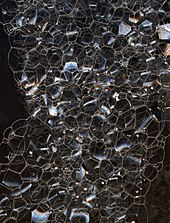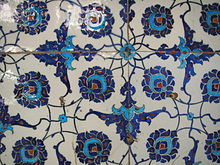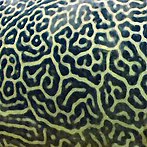Pattern
Apatternis a regularity in the world, in human-made design,[1]or inabstractideas. As such, the elements of a pattern repeat in a predictable manner. Ageometric patternis a kind of pattern formed ofgeometricshapesand typically repeated like awallpaperdesign.
Any of thesensesmay directly observe patterns. Conversely, abstract patterns inscience,mathematics,orlanguagemay be observable only by analysis. Direct observation in practice means seeing visual patterns, which are widespread in nature and in art. Visualpatterns in natureare oftenchaotic,rarely exactly repeating, and often involvefractals.Natural patterns includespirals,meanders,waves,foams,tilings,cracks,and those created bysymmetriesofrotationandreflection.Patterns have an underlyingmathematicalstructure;[2]: 6 indeed, mathematics can be seen as the search for regularities, and the output of any function is a mathematical pattern. Similarly in the sciences, theories explain and predict regularities in the world.
In many areas of thedecorative arts,from ceramics and textiles towallpaper,"pattern" is used for an ornamental design that is manufactured, perhaps for many different shapes of object. In art and architecture, decorations orvisual motifsmay be combined and repeated to form patterns designed to have a chosen effect on the viewer.
Nature
[edit]Nature provides examples of many kinds of pattern, includingsymmetries,trees and other structures with afractaldimension,spirals,meanders,waves,foams,tilings,cracksand stripes.[3]
Symmetry
[edit]
Symmetry is widespread in living things. Animals that move usually have bilateral ormirror symmetryas this favours movement.[2]: 48–49 Plants often have radial orrotational symmetry,as do many flowers, as well as animals which are largely static as adults, such assea anemones.Fivefold symmetry is found in theechinoderms,includingstarfish,sea urchins,andsea lilies.[2]: 64–65
Among non-living things,snowflakeshave strikingsixfold symmetry:each flake is unique, its structure recording the varying conditions during its crystallisation similarly on each of its six arms.[2]: 52 Crystalshave a highly specific set of possiblecrystal symmetries;they can be cubic oroctahedral,but cannot have fivefold symmetry (unlikequasicrystals).[2]: 82–84
Spirals
[edit]
Spiral patterns are found in the body plans of animals includingmolluscssuch as thenautilus,and in thephyllotaxisof many plants, both of leaves spiralling around stems, and in the multiple spirals found in flowerheads such as thesunflowerand fruit structures like thepineapple.[4]
Chaos, turbulence, meanders and complexity
[edit]
Chaos theorypredicts that while the laws ofphysicsaredeterministic,there are events and patterns in nature that never exactly repeat because extremely small differences in starting conditions can lead to widely differing outcomes.[5]The patterns in nature tend to be static due to dissipation on the emergence process, but when there is interplay between injection of energy and dissipation there can arise a complex dynamic.[6]Many natural patterns are shaped by this complexity, includingvortex streets,[7]other effects of turbulent flow such asmeandersin rivers.[8]or nonlinear interaction of the system[9]
Waves, dunes
[edit]

Wavesare disturbances that carry energy as they move.Mechanical wavespropagate through a medium – air or water, making itoscillateas they pass by.[10]Wind wavesaresurface wavesthat create the chaotic patterns of the sea. As they pass over sand, such waves create patterns of ripples; similarly, as the wind passes over sand, it creates patterns ofdunes.[11]
Bubbles, foam
[edit]
FoamsobeyPlateau's laws,which require films to be smooth and continuous, and to have a constantaverage curvature.Foam and bubble patterns occur widely in nature, for example inradiolarians,spongespicules,and the skeletons ofsilicoflagellatesandsea urchins.[12][13]
Cracks
[edit]
Cracksform in materials to relieve stress: with 120 degree joints in elastic materials, but at 90 degrees in inelastic materials. Thus the pattern of cracks indicates whether the material is elastic or not. Cracking patterns are widespread in nature, for example in rocks, mud, tree bark and the glazes of old paintings and ceramics.[14]
Spots, stripes
[edit]Alan Turing,[15]and later the mathematical biologistJames D. Murray[16]and other scientists, described a mechanism that spontaneously creates spotted or striped patterns, for example in the skin of mammals or the plumage of birds: areaction–diffusionsystem involving two counter-acting chemical mechanisms, one that activates and one that inhibits a development, such as of dark pigment in the skin.[17]Thesespatiotemporal patternsslowly drift, the animals' appearance changing imperceptibly as Turing predicted.
Art and architecture
[edit]Tilings
[edit]
In visual art, pattern consists in regularity which in some way "organizes surfaces or structures in a consistent, regular manner." At its simplest, a pattern in art may be a geometric or other repeating shape in apainting,drawing,tapestry,ceramictilingorcarpet,but a pattern need not necessarily repeat exactly as long as it provides some form or organizing "skeleton" in the artwork.[18]In mathematics, atessellationis the tiling of a plane using one or more geometric shapes (which mathematicians call tiles), with no overlaps and no gaps.[19]
Zentangle
[edit]The materials and teaching tools of Zentangle® (a blend of meditativeZenpractice with the purposeful drawing of repetitive patterns or artistic tangles) has been copyrighted by Rick Roberts and Maria Thomas.[20]The process, using patterns such ascross hatching,dots, curves and other mark making, on small pieces of paper or tiles which can then be put together to formmosaicclusters, or shaded or coloured in, can, like thedoodle,be used as a therapeutic device to help to relieve stress, anxiety and depressive symptoms in children, adults and older adults.[21][22][23]
In architecture
[edit]
In architecture,motifsare repeated in various ways to form patterns. Most simply, structures such as windows can be repeated horizontally and vertically (see leading picture). Architects can use and repeat decorative and structural elements such ascolumns,pediments,andlintels.[24]Repetitions need not be identical; for example, temples in South India have a roughly pyramidal form, where elements of the pattern repeat in afractal-like way at different sizes.[25]

Science and mathematics
[edit]
Mathematicsis sometimes called the "Science of Pattern", in the sense of rules that can be applied wherever needed.[26]For example, anysequenceof numbers that may be modeled by a mathematical function can be considered a pattern. Mathematics can be taught as a collection of patterns.[27]
Gravityis a source of ubiquitous scientific patterns or patterns of observation. The sun rising and falling pattern each day results from the rotation of the earth while in orbit around the sun. Likewise, themoon'spath through the sky is due to its orbit of the earth. These examples, while perhaps trivial, are examples of the "unreasonable effectiveness of mathematics" which obtain due to thedifferential equationswhose application withinphysicsfunction to describe the most generalempiricalpatterns of theuniverse.[28]
Real patterns
[edit]Daniel Dennett's notion of real patterns, discussed in his 1991 paper of the same name,[29]provides an ontological framework aiming to discern the reality of patterns beyond mere human interpretation, by examining their predictive utility and the efficiency they provide in compressing information. For example,centre of gravityis a real pattern because it allows us to predict the movements of a bodies such as the earth around the sun, and it compresses all the information about all the particles in the sun and the earth that allows us to make those predictions.
Fractals
[edit]Some mathematical rule-patterns can be visualised, and among these are those that explainpatterns in natureincluding the mathematics of symmetry, waves, meanders, and fractals.Fractalsare mathematical patterns that are scale invariant. This means that the shape of the pattern does not depend on how closely you look at it.Self-similarityis found in fractals. Examples of natural fractals are coast lines and tree shapes, which repeat their shape regardless of what magnification you view at. While self-similar patterns can appear indefinitely complex, the rules needed to describe or produce theirformationcan be simple (e.g.Lindenmayer systemsdescribingtreeshapes).[30]
Inpattern theory,devised byUlf Grenander,mathematicians attempt to describe the world in terms of patterns. The goal is to lay out the world in a more computationally friendly manner.[31]
In the broadest sense, any regularity that can be explained by a scientific theory is a pattern. As in mathematics, science can be taught as a set of patterns.[32]
A recent study from Aesthetics and Psychological Effects of Fractal Based Design[33]suggested that fractal patterns possess self-similar components that repeat at varying size scales. The perceptual experience of human-made environments can be impacted with inclusion of these natural patterns. Previous work has demonstrated consistent trends in preference for and complexity estimates of fractal patterns. However, limited information has been gathered on the impact of other visual judgments. Here we examine the aesthetic and perceptual experience of fractal ‘global-forest’ designs already installed in humanmade spaces and demonstrate how fractal pattern components are associated with positive psychological experiences that can be utilized to promote occupant wellbeing. These designs are composite fractal patterns consisting of individual fractal ‘tree-seeds’ which combine to create a ‘global fractal forest.’ The local ‘tree-seed’ patterns, global configuration of tree-seed locations, and overall resulting ‘global-forest’ patterns have fractal qualities. These designs span multiple mediums yet are all intended to lower occupant stress without detracting from the function and overall design of the space. In this series of studies, we first establish divergent relationships between various visual attributes, with pattern complexity, preference, and engagement ratings increasing with fractal complexity compared to ratings of refreshment and relaxation which stay the same or decrease with complexity. Subsequently, we determine that the local constituent fractal (‘tree-seed’) patterns contribute to the perception of the overall fractal design, and address how to balance aesthetic and psychological effects (such as individual experiences of perceived engagement and relaxation) in fractal design installations. This set of studies demonstrates that fractal preference is driven by a balance between increased arousal (desire for engagement and complexity) and decreased tension (desire for relaxation or refreshment). Installations of these composite mid-high complexity ‘global-forest’ patterns consisting of ‘tree-seed’ components balance these contrasting needs, and can serve as a practical implementation of biophilic patterns in human-made environments to promote occupant wellbeing.
See also
[edit]References
[edit]- ^Garai, Achraf (3 March 2022)."What are design patterns?".achrafgarai.Retrieved1 January2023.
- ^abcdeStewart, Ian (2001).What shape is a snowflake?.London: Weidenfeld & Nicolson.ISBN0-297-60723-5.OCLC50272461.
- ^Stevens, Peter.Patterns in Nature,1974. Page 3.
- ^Kappraff, Jay (2004)."Growth in Plants: A Study in Number"(PDF).Forma.19:335–354. Archived fromthe original(PDF)on 2016-03-04.Retrieved2013-01-18.
- ^Crutchfield, James P; Farmer, J Doyne; Packard, Norman H; Shaw, Robert S (December 1986). "Chaos".Scientific American.254(12): 46–57.Bibcode:1986SciAm.255f..46C.doi:10.1038/scientificamerican1286-46.
- ^Clerc, Marcel G.; González-Cortés, Gregorio; Odent, Vincent; Wilson, Mario (29 June 2016). "Optical textures: characterizing spatiotemporal chaos".Optics Express.24(14): 15478–85.arXiv:1601.00844.Bibcode:2016OExpr..2415478C.doi:10.1364/OE.24.015478.PMID27410822.S2CID34610459.
- ^von Kármán, Theodore.Aerodynamics.McGraw-Hill (1963):ISBN978-0070676022.Dover (1994):ISBN978-0486434858.
- ^Lewalle, Jacques (2006)."Flow Separation and Secondary Flow: Section 9.1"(PDF).Lecture Notes in Incompressible Fluid Dynamics: Phenomenology, Concepts and Analytical Tools.Syracuse, NY: Syracuse University. Archived fromthe original(PDF)on 2011-09-29.
- ^Scroggie, A.J; Firth, W.J; McDonald, G.S; Tlidi, M; Lefever, R; Lugiato, L.A (August 1994)."Pattern formation in a passive Kerr cavity"(PDF).Chaos, Solitons & Fractals.4(8–9): 1323–1354.Bibcode:1994CSF.....4.1323S.doi:10.1016/0960-0779(94)90084-1.
- ^French, A.P.Vibrations and Waves.Nelson Thornes, 1971.[full citation needed]
- ^Tolman, H.L. (2008)."Practical wind wave modeling"(PDF).In Mahmood, M.F. (ed.).CBMS Conference Proceedings on Water Waves: Theory and Experiment.Howard University, USA, 13–18 May 2008. World Scientific Publ.
- ^Ball, Philip.Shapes,2009. pp. 68, 96-101.[full citation needed]
- ^Frederick J. Almgren, Jr.andJean E. Taylor,The geometry of soap films and soap bubbles,Scientific American, vol. 235, pp. 82–93, July 1976.
- ^Stevens, Peter. 1974. Page 207.
- ^Turing, A. M. (1952). "The Chemical Basis of Morphogenesis".Philosophical Transactions of the Royal Society B.237(641): 37–72.Bibcode:1952RSPTB.237...37T.doi:10.1098/rstb.1952.0012.S2CID937133.
- ^Murray, James D. (9 March 2013).Mathematical Biology.Springer Science & Business Media. pp. 436–450.ISBN978-3-662-08539-4.
- ^Ball, Philip.Shapes,2009. pp. 159–167.[full citation needed]
- ^Jirousek, Charlotte (1995)."Art, Design, and Visual Thinking".Pattern.Cornell University.Retrieved12 December2012.
- ^Grünbaum, Branko; Shephard, G. C. (1987).Tilings and Patterns.New York: W. H. Freeman.ISBN9780716711933.
- ^"Zentangle".Zentangle.Retrieved2023-02-03.
- ^Hsu, M.F. (July 2021)."Effects of Zentangle art workplace health promotion activities on rural healthcare workers".Public Health.196:217–222.doi:10.1016/j.puhe.2021.05.033.PMID34274696.S2CID236092775.
- ^Chung, S.K. (September 2022)."The effects of Zentangles on affective well-being among adults".American Journal of Occupational Therapy.1(76).doi:10.5014/ajot.2022.049113.PMID35943847.S2CID251444115.
- ^Chan, Henri Chun-Yiu; Lo, Herman Hay-Ming (2023-05-05)."Effects of the original zentangle method on older adults with depressive symptoms a randomized waitlist-controlled trial".Current Psychology.43(6): 5065–5077.doi:10.1007/s12144-023-04536-x.ISSN1936-4733.PMC10161183.PMID37359601.
- ^Adams, Laurie (2001).A History of Western Art.McGraw Hill. p. 99.
- ^Jackson, William Joseph (2004).Heaven's Fractal Net: Retrieving Lost Visions in the Humanities.Indiana University Press. p. 2.
- ^Resnik, Michael D. (November 1981). "Mathematics as a Science of Patterns: Ontology and Reference".Noûs.15(4): 529–550.doi:10.2307/2214851.JSTOR2214851.
- ^Bayne, Richard E (2012)."MATH 012 Patterns in Mathematics - spring 2012".Archived fromthe originalon 7 February 2013.Retrieved16 January2013.
- ^Steen, Lynn (June 1988)."The Science of Patterns".Science.240(4852): 611–616.doi:10.1126/science.240.4852.611.Retrieved2024-08-11.The author attributes Eugene Wigner for the claim for the "unreasonable effectiveness of mathematics," a partial quote which continues "[t]he miracle of the appropriateness of the language of mathematics for the formulation of the laws of physics is a wonderful gift which we neither understand nor deserve."
- ^Dennett, D. C. (1991). Real Patterns. The Journal of Philosophy, 88(1), 27-51.
- ^Mandelbrot, Benoit B.(1983).The fractal geometry of nature.Macmillan.ISBN978-0-7167-1186-5.
- ^Grenander, Ulf; Miller, Michael (2007).Pattern Theory: From Representation to Inference.Oxford University Press.
- ^"Causal Patterns in Science".Harvard Graduate School of Education. 2008.Retrieved16 January2013.
- ^Robles, Kelly E.; Roberts, Michelle; Viengkham, Catherine; Smith, Julian H.; Rowland, Conor; Moslehi, Saba; Stadlober, Sabrina; Lesjak, Anastasija; Lesjak, Martin; Taylor, Richard P.; Spehar, Branka; Sereno, Margaret E. (2021)."Aesthetics and Psychological Effects of Fractal Based Design".Frontiers in Psychology.12.doi:10.3389/fpsyg.2021.699962.ISSN1664-1078.PMC8416160.PMID34484047.
Bibliography
[edit]In nature
[edit]- Adam, John A.Mathematics in Nature: Modeling Patterns in the Natural World.Princeton, 2006.
- Ball, PhilipThe Self-made Tapestry: Pattern Formation in Nature.Oxford, 2001.
- Edmaier, BernhardPatterns of the Earth.Phaidon Press,2007.
- Haeckel, ErnstArt Forms of Nature.Dover, 1974.
- Stevens, Peter S.Patterns in Nature.Penguin, 1974.
- Stewart, Ian.What Shape is a Snowflake? Magical Numbers in Nature.Weidenfeld & Nicolson,2001.
- Thompson, D'Arcy W.On Growth and Form.1942 2nd ed. (1st ed., 1917).ISBN0-486-67135-6
In art and architecture
[edit]- Alexander, C.A Pattern Language: Towns, Buildings, Construction.Oxford, 1977.
- de Baeck, P.Patterns.Booqs, 2009.
- Garcia, M.The Patterns of Architecture.Wiley, 2009.
- Kiely, O.Pattern.Conran Octopus, 2010.
- Pritchard, S.V&A Pattern: The Fifties.V&A Publishing, 2009.
In science and mathematics
[edit]- Adam, J. A.Mathematics in Nature: Modeling Patterns in the Natural World.Princeton, 2006.
- Resnik, M. D.Mathematics as a Science of Patterns.Oxford, 1999.
In computing
[edit]- Gamma, E., Helm, R., Johnson, R., Vlissides, J.Design Patterns.Addison-Wesley, 1994.
- Bishop, C. M.Pattern Recognition and Machine Learning.Springer, 2007.









